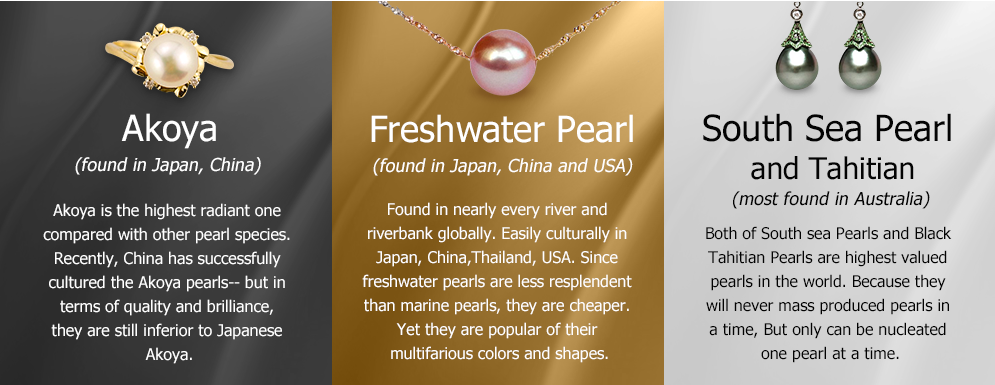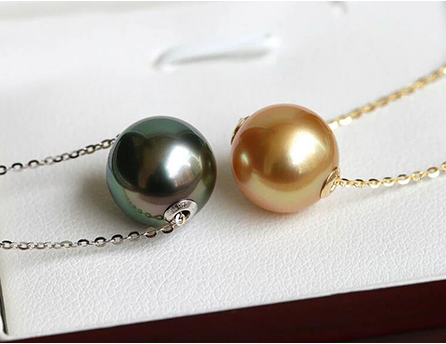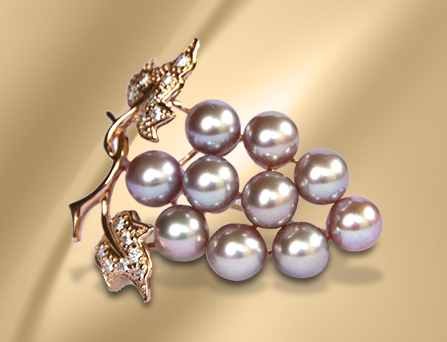
Pearl is the only jewel generating out of the living creatures. Such tine-honored ornament is produce of a species named mother- of-pearl.
There are both univalve and bivalve categories of this species:
1. Natural pearl
Some pebbles, sand mixing with food so irritate the mother-of-pearl that it must releases a slime comprising calcium carbonate to coat such irritants. As weeks pass by some strong, resplendent spherie substance occurs called "Pearl" or "Nacre."2. Cultured pearl
As the natural pearls are rare and expensive, a Japanese named Kokichi Mikimoto was the inventor of the world's first cultured pearl. Initially, he inserted an imitation pearl into the mother-of-pearl. As a result, it yielded an ornate nacre. Later, both marine and freshwater mother-of-pearl species were cultured for such purpose. Shells of the freshwater species are bivalve, large, thick and yield nacreous layer luster. Further, their meat is delectable; their shells are radiant ornament, utensil. But most interesting is their pearl-which can also be applied as ingredient of cosmetics and medicines (Binhe, 1984).
The black pearl(Tahitian pearl) oyster origin is found in Tahiti Island and some of other Pacific Island areas has been extensively used for
producing cultured pearls for them such as south sea pearl oyster, Since the culturing process
This white pearls are marine species. They are fertile only in tropical, humid zone, or semitropical zone in Oceania. Their size varies from 10-20 mm. This pearl is somewhat expensive due to its rarity and large size.
This white pearls are marine species. They are fertile only in tropical, humid zone, or semitropical zone in Oceania. Their size varies from 10-20 mm. This pearl is somewhat expensive due to its rarity and large size.

Authentic & Artificial Pearls
Artificial pearls are not deemed a valuable jewel. Five artificial pearls are made of crystal, ceramic, shell or plastic coated of with lacquer to imitation of authentic tic pearl's rainbow radiance. Artificial pearl is known in several names: imitation pearl, synthetic pearl, invented pearl, fashion pearl. Through visual detection by a pearl expert, we can distinguish which one is authentic or artificial. But advanced technology and sophistiusted process recently deceive customer selection. Thereby the easiest test method is by your teeth. Artificial pearl will yield a slippery touch, while authentic pearl will yield a sticky touch when bitten. Another method is grilling: authentic pearl will neither yield soot nor get burnt. Yet some artificial pearls are already advanced to a degree of sootlessness when exposed to fire!Maintenance
ue to pearl's delicate character , special care is needed for preservation of its luster and grandiosity. The matters that will reduce pearl's radiance are cosmetics, perfume, hairspray, acid-mixed body lotion, other chemicals. Thus the best way is to wear pearl ornament after, not before, your facial makeup or hair styling. And before retention, just softly rub it with a soft fabric and occasionally wash it with warm soapwater. Then separately keep pearl from any other object--in prevention of any scratch. Best storage is a velvet or soft fabric box. In case you wear pearl necklace many times a week, you should replace its thread once a year to prevent any tearing.Pearl for Special Persons and Occasions
In ancient era, pearl was a gift signifying love. This traditional and popular jewel is now used as bride's ornament due to the deepest warmness and timelessness it brings.There by pearl is worldwide used as a precious gift sent to beloved ones since pearl is available in various styles and prices.
Pearl gift is ideal for: a 16th year birth anniversary, a 1-year, 12-year, 30-year wedding anniversary. Pearl is the auspicious jewel for people










